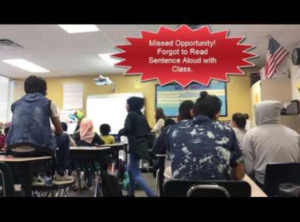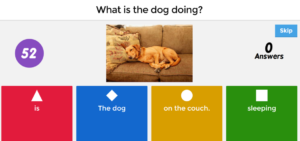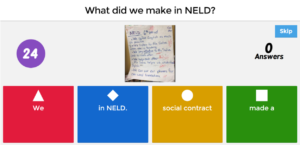Using Kahoot! to help Language Learners through ‘The Silent Period’
If you teach new language learners, you are probably familiar with “The Silent Period.” This is the time when a learner is so new to a language that they can’t attempt to speak it. Some students become more familiar with the language but still do not make enough attempts to speak the language.
There are several reasons for this but my students have told me that they are apprehensive about speaking English because they don’t like how they sound. This is a shame because I know language production – i.e. speaking – is key to retaining and internalizing content.
When new students arrive in our class, we take time to review our classroom rules and norms together. These class norms are great for everyone to practice speaking English in complete sentences. I made a kahoot to practice these norms and this 3 minute video shows how I guide the students in producing the language for each question.

In the video, there are students who were brand new in class that day. Did you notice how engaged all the students are? I make it a goal to have all new students practicing speaking language in a low stress way as much as possible, and this is possible with Kahoot!
The more practice students have in the language they are learning, the faster they will feel comfortable producing the language independently.
Kahoot! Jumble in the ESL Classroom
Jumble has all the fun of a regular Kahoot! quiz but it challenges my students to put words or phrases in a particular order, which requires more focus.
My students generally learn sentence structure and grammar in context but these concepts should be reviewed. Students are much more engaged when reviewing grammar if the experience is fun and gamified.
For example, the below Jumble question may seem very basic but not all languages use prepositional phrases in the way English does.

Wherever possible, I include photos of the students doing scholarly things in my Jumble questions. This serves the purpose of teaching structures of English AND building confidence in my students. Here is an example:

Lastly, it’s important to show sentences that could be ordered in more than one way. Jumble provides my students a chance to attempt the correct order and then time to discuss reasons around the right answer. In the below case, the capital letter and period are what should lead students to chose “We made a social contract in NELD.” instead of “In NELD, we made a social contract.” Both are correct, but we can talk about why that is, and also to point out the importance of the punctuation:

Finally, with Jumble, I also weave in principles of gaining literacy in the target language:

Building Cultural Knowledge for Language Learners
Another way I use Kahoot! is to help build cultural knowledge and context for language learners. Many of our recent immigrants have rich experiences but may be lack knowledge in the country’s history or culture.
I created a true/false guessing game kahoot for a group of 4th grade students, about the history of our location. We stopped between each questions to talk about the right answers. These were designed to inspire curiosity about the content before it was taught:

Anticipation Guide and Structured Conversations for Language Learners
I showed the curiosity-building idea above to a group of educators in Dallas, TX and they loved it. Marie Heath of Plano ISD suggested that we turn off the points feature in a kahoot game to be able to use something like this as an anticipation guide to be played prior to a lesson.
In this scenario, the questions would be framed statements with the option to select “I agree” or “I disagree” as answers. Instead of right or wrong answers, the students would see how the others feel about the statements presented. This is a fantastic idea to set up a structured conversation between cooperative groups.
Anticipation guides can be repeated after the lesson. Students have a chance to see if their thinking has changed now that they have had a chance to learn more information about a topic.
Final Word
As an ESL teacher, I am grateful to have Kahoot! as an education partner. My role is far more complex than just teaching English to my students. I need to inspire curiosity, build confidence and grow future leaders. I am thrilled to have a tool that helps me with all of that and more.
It is exciting to see these students as they accelerate their learning and close their academic gaps. I appreciate global and authentic learning opportunities because we are not just here to close gaps in academic skills.
We need these students to inspire others to realize what is possible with hard work and we also want to balance that with the kind of experiences that will help them to become future leaders themselves. Any of our students have this potential and the kids in my classroom have expressed a strong desire to be a positive change in the world.
Thanks for reading my series on Kahoot! and Language Learning, and follow me for more @MsSalvac!





